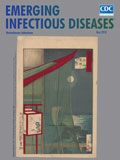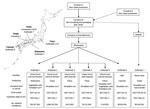
Volume 24, Number 5—May 2018
Dispatch
Foodborne Outbreaks Caused by Human Norovirus GII.P17-GII.17–Contaminated Nori, Japan, 2017
On This Page
Article Metrics
Altmetric:
Citations: 0
Views: 342Views equals page views plus PDF downloads
Metric DetailsNaomi Sakon , Kenji Sadamasu, Takayuki Shinkai, Yousuke Hamajima, Hideaki Yoshitomi, Yuki Matsushima, Rika Takada, Fumio Terasoma, Asako Nakamura, Jun Komano, Koo Nagasawa, Hideaki Shimizu, Kazuhiko Katayama, and Hirokazu Kimura
, Kenji Sadamasu, Takayuki Shinkai, Yousuke Hamajima, Hideaki Yoshitomi, Yuki Matsushima, Rika Takada, Fumio Terasoma, Asako Nakamura, Jun Komano, Koo Nagasawa, Hideaki Shimizu, Kazuhiko Katayama, and Hirokazu Kimura
Abstract
Seven foodborne norovirus outbreaks attributable to the GII.P17-GII.17 strain were reported across Japan in 2017, causing illness in a total of 2,094 persons. Nori (dried shredded seaweed) was implicated in all outbreaks and tested positive for norovirus. Our data highlight the stability of norovirus in dehydrated food products.

Figure. Overview of foodborne norovirus outbreaks associated with dried shredded nori during the 2016–17 endemic season, Japan. Production and distribution of dried, shredded nori products and the 7 norovirus outbreaks are outlined....
Seven foodborne norovirus outbreaks were reported in 4 remote areas across Japan during January–February 2017, causing illness in 2,094 persons (Figure). In all outbreaks, norovirus GII.P17-GII.17 was detected in stool specimens of patients. Food survey results indicated that dried shredded seaweed (nori) was served before all outbreaks. Norovirus was also detected in nori-containing dishes. An investigation revealed that the nori served in each instance was manufactured by the same food processing company.
Outbreak 1 was reported on January 26 in 4 kindergartens, 6 elementary schools, and 5 junior high schools in the prefecture of Wakayama, Japan (1). A total of 1,943 children and 119 school staff members had eaten lunch the day before; of these, 678 (34.9%) children and 85 (71.4%) school staff members had acute gastroenteritis. Norovirus was also detected in the stool specimens from 10 of the 27 food handlers in the central kitchen who had eaten the same lunch. Food survey results indicated that boiled vegetables mixed with shredded nori was responsible for this outbreak.
Outbreak 2 was reported on February 17 in 7 elementary schools in the city of Tachikawa, part of metropolitan Tokyo, Japan (1). A total of 1,084 (35.2%) of the 3,078 persons who ate the lunch served the day before had gastrointestinal symptoms. The lunch included shredded nori as a topping on cooked rice.
Outbreaks 3 and 4 were reported in separate, self-catered school lunch settings on February 22 and 25 in the city of Kodaira, also part of metropolitan Tokyo (1). The numbers of patients with gastrointestinal symptoms were 26 (5.6% attack rate) in outbreak 3 and 81 (12.6% attack rate) in outbreak 4. Shredded nori was served as a topping on cooked rice in both outbreaks.
Outbreak 5 was reported in Western Tama, also in metropolitan Tokyo, on February 27. A central kitchen served school lunch to 19 persons, and 2 of them (10.5%) had gastrointestinal symptoms. Shredded nori was served with boiled vegetables.
Outbreak 6 was reported on March 9. After conducting retrospective surveillance, the Kurume city government in Fukuoka prefecture announced that a foodborne outbreak occurred in a business office on January 25 that was attributable to a nori product with the same expiration date as the nori implicated in outbreaks 1–5. A total of 39 (92%) of the 42 employees who had eaten at the office’s café had gastrointestinal symptoms. Shredded nori had been served as a salad topping.
Outbreak 7, announced by the Osaka prefectural government, caused illness in 99 persons during February 18–24, including 4 food handlers who consumed a bento box (a single-portion take-out or home-packed meal common in Japanese cuisine). A bento shop provided 228 meal boxes during this period that contained nori product from company B. Those who had eaten from bento boxes without nori also had gastrointestinal symptoms.
We detected norovirus in nori-containing food in outbreak 1 by using the PANSORBIN-trap method (2). Tokyo Metropolitan Institute of Public Health tested norovirus from food from outbreaks 2–5 by using the A3T method, by which nori was incubated with the Proteus vulgaris NBRC3045 strain (3). Among 21 nori samples, including those from the merchandise in stock of the wholesaler and those that remained in the kitchen from outbreaks 2–5 in Tokyo, 7 samples were positive for norovirus GII.17 by nested reverse transcription PCR (4–6). These data, along with the food survey results, strongly suggest that nori was responsible for the foodborne norovirus outbreaks.
The amount of shredded nori served as a topping on cooked rice was 0.5–1.0 g per dish. The shredded nori contained 360–2,900 copies/g of norovirus genome, a measure that did not take into account the recovery rate of the virus particles from the food (4). In outbreak 7, food handlers shared and reused plastic gloves, which increased the risk for norovirus contamination across food.
Nori sheets were originally produced by company C, and food processing company B shredded them to 2-mm width and packed them with desiccants (Figure). Approximately 800 packages were produced, shipped to company A on December 10 and 27, 2016, and sold under the company A brand with the same expiration date. Another batch was produced by company B in December 2016 and sold under its own brand with an expiration date of May 31, 2017. These packages were stored at an ambient temperature.
On February 27, 2017, the Osaka city government announced that norovirus GII.17 was detected from 8 of 25 environmental wipe samples at company B. These samples were subjected to ultracentrifugation to precipitate norovirus particles before nucleic acid extraction. Samples collected from the nori sheet shredding equipment, a telephone handle, and the toilet were positive for norovirus. At company B, an employee who was responsible for the shredding step had gastrointestinal symptoms before the production of the nori in question in late December 2016 but nevertheless continued working. No outbreak had been reported after the products were recalled, and the business of company B was suspended. Investigators suspected that the nori was contaminated with norovirus during the shredding process at company B.
Most foodborne outbreaks in Japan are attributable to norovirus GII.P17-GII.17, a novel variant that emerged in Asia during 2014–2015 (7,8). The genome sequence spanning the N terminus of the major capsid protein (VP1) gene, a short 302-nt region that is routinely sequenced, was identical among the GII.P17-GII.17 strains isolated in Japan during the 2016–17 season. Therefore, we sequenced and analyzed 2 virus genes, RNA-dependent RNA polymerase (RdRp) (1,530 nt) and VP1 (1,620 nt). For all 7 outbreaks, the sequence identities of these 2 genes derived from patient stool specimens were 100% identical (Table). As a comparison, we analyzed norovirus GII.P17-GII.17 strains detected from 4 independent outbreaks unrelated to nori products during the same season in Osaka (Table). The sequences of 2 genes among these strains were not identical with those related to nori-associated outbreaks, and phylogenetic tree analyses of the RdRp gene showed that sequences associated with the nori-related norovirus outbreaks formed a distinct cluster from the outbreaks unrelated to nori (Technical Appendix[PDF - 180 KB - 1 page] Figure). These results and epidemiologic link indicated that all 7 outbreaks were attributable to GII.P17-GII.17–contaminated shredded nori.
Our study demonstrated that 7 foodborne norovirus outbreaks in 4 remote regions of Japan were attributable to a shredded nori product that was most likely contaminated during manufacturing. From a technical standpoint, the recovery of norovirus genomic RNA from food is not efficient, so identifying the contaminated food can be difficult; however, the PANSORBIN-trap and A3T methods were shown to be useful for this purpose. Sequence analysis of the RdRp and VP1 regions of the norovirus genome enabled us to distinguish nori-related outbreaks involving norovirus GII.P17-GII.17 from other outbreaks involving the same genotype.
Few dry food–associated foodborne outbreaks with norovirus have been reported previously. In 2014, a large norovirus outbreak involving 1,271 persons was reported in which bread was contaminated with norovirus. The contaminated bread was served at school lunch within 2 days after production (9). In contrast, in these nori-related outbreaks, the traceback of implicated nori product revealed that the norovirus infectivity remained for >2 months at ambient temperature under dry conditions. However, the percentage of persons with gastrointestinal symptoms gradually decreased from the date of nori production, suggesting a decline in norovirus infectivity over time under dry conditions.
Dr. Sakon is a senior research scientist whose primary research interests include public health and viral infections of the gastrointestinal tract.
Acknowledgments
We are grateful to Mamoru Noda for information on the PANSORBIN-trap method and to Jan Vinjé for valuable comments on the manuscript.
The Japan Agency for Medical Research and Development supported this work.
Author contributions: Detection of norovirus and genetic analysis were managed by each institute of public health. Y.M. and H.S. designed specific primers for GII.P17-GII.17. K.N., H.K., and N.S. conducted the phylogenetic tree analysis. N.S. and J.K. wrote the manuscript. All authors commented on the manuscript.
References
- Kusumi E, Tanimoto T, Hosoda K, Tsubokura M, Hamaki T, Takahashi K, et al. Multiple norovirus outbreaks due to shredded, dried, laver seaweed in Japan. Infect Control Hosp Epidemiol. 2017;38:885–6. DOIPubMed
- Saito H, Toho M, Tanaka T, Noda M. Development of a practical method to detect noroviruses contamination in composite meals. Food Environ Virol. 2015;7:239–48. DOIPubMed
- Akiba T, Nagano M, Tanaka T, Mori K, Hayashi Y, Kai A. Feasibility of employing a bacterial culture method (A3T method) for detection of norovirus in oysters [in Japanese]. Jpn J Food Microbiol. 2011;28:128–32.
- Somura Y, Kimoto K, Oda M, Okutsu Y, Kato R, Suzuki Y, et al. Serial food poisoning outbreaks caused by norovirus-contaminated shredded dried laver seaweed provided at school lunch, Tokyo, 2017 [in Japanese]. Shokuhin Eiseigaku Zasshi. 2017;58:260–7. DOIPubMed
- Kojima S, Kageyama T, Fukushi S, Hoshino FB, Shinohara M, Uchida K, et al. Genogroup-specific PCR primers for detection of Norwalk-like viruses. J Virol Methods. 2002;100:107–14. DOIPubMed
- Kageyama T, Kojima S, Shinohara M, Uchida K, Fukushi S, Hoshino FB, et al. Broadly reactive and highly sensitive assay for Norwalk-like viruses based on real-time quantitative reverse transcription-PCR. J Clin Microbiol. 2003;41:1548–57. DOIPubMed
- Matsushima Y, Ishikawa M, Shimizu T, Komane A, Kasuo S, Shinohara M, et al. Genetic analyses of GII.17 norovirus strains in diarrheal disease outbreaks from December 2014 to March 2015 in Japan reveal a novel polymerase sequence and amino acid substitutions in the capsid region. Euro Surveill. 2015;20:21173. DOIPubMed
- Chan MCW, Hu Y, Chen H, Podkolzin AT, Zaytseva EV, Komano J, et al. Global spread of norovirus GII.17 Kawasaki 308, 2014–2016. Emerg Infect Dis. 2017;23:1359–1354. DOIPubMed
- Tsuchiya Y, Sahara A, Jinbo T, Nakano T, Kato K, Ogai T, et al. A foodborne outbreak of norovirus caused by bread [in Japanese]. Jpn J Food Microbiol. 2015;32:153–8.






















.png)











No hay comentarios:
Publicar un comentario